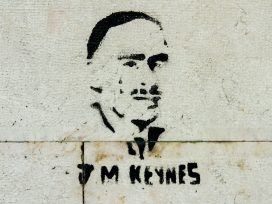“The return of political economy to history” – this was the title of the Berlin Colloquium a few months ago. But had political economy ever really disappeared? Perhaps, relative to other specializations, it had claimed less attention from historians in recent decades; but of course it was hardly less relevant to developments in the world that historians were supposed to study. Why had it apparently ceased to serve as a methodology or approach? This little essay will try to suggest an answer. A related problem has bothered economists, who have taken note of the supposed disappearance of economic history and the history of economic thought as central concerns of their profession. The search for a remedy prompted a Cambridge, Massachusetts discussion two months after the Berlin meeting, as the Institute for New Economic Thinking (INET) summoned economists and economic historians to reflect on how economic history might claim a larger role in both economics and history departments.
The premise of both gatherings, in which this author participated – and no doubt of others as well, at which he was not present – was the same. Important approaches to analyzing society and economy, past and present, had fallen into disuse, even as they promised important and even necessary insight. From the viewpoint of the economists, “mainstream” analysis – the axiomatic “macro” and “micro” theory that culminated in general equilibrium theory expressed in partial differential equations – was thriving. From the viewpoint of the historians, social history, cultural history, the history of international and civil conflict, had claimed the efforts of young researchers, intellectuals, and the public in general for more than a decade. But somehow economic history, the history of economic thought and the history of political economy, had been eclipsed. But now, so the participants in both gatherings concluded, political economy was back or deserved to be back.
An economics for hard times
Simply put, what we call political economy today is an approach that emerges from perceived crisis or malfunctioning. Historians and public commentators search history for the antecedents and the analogues of current difficulties. If political economy is returning as a tool for history it must be returning to current politics as well. Political economy is on the historian’s agenda because it is on the policy agenda. Social scientists pursue disinterested truth, but they do not pursue topics of no interest. Let’s face it: crisis provokes interest. We ransack the past for guidance and we turn to analogies, whether they hold up or not. Are we concerned about a possible clash between the major powers in the South China Sea? If so we leaf through our Thucydides to read what he wrote about the decline of Athens. Are we worried about crises escalating into war? We go back to the summer of 1914. Are we concerned about the lingering economic malaise that afflicts Europe? We look to the Great Depression after 1929. Historians dine out, so to speak, on prior catastrophes.
Economic history had not in fact disappeared although in the past twenty years its roll has much diminished. But the economic history reflected in the work of David Landes, Alexander Gerschenkron and other contributors of the preceding generation largely reflected the good times of the years since 1948: les trente gloriouses as Fourastié called the epoch. It was the history of economic development and growth: an agenda that, as Gerschenkron openly confessed, saw British industrialization as the model trajectory and sought to explain why other countries had diverged from the British or the Anglo-American model. France was slow, Germany and Russia were late, most of Eastern Europe (and of course Africa and Asia) were backward. Yet the secrets of “sustained economic growth”, in Kuznets’s phrase, could be applied to these backward economies – growth and development were the heroic tasks for economists, and those undertaking them looked forward, not back. One learned the lessons of history – how to develop and institutionalize growth – and one went on.
This historical agenda persisted despite the fact that the thirty postwar years had been followed by a decade of stagflation. By the mid 1980s, progress and growth was not so glorious as the 1950s and 1960s, but robust nonetheless – and certainly so in comparison with the state socialist economies that were headed toward collapse. And not only had the western economies prospered, they had had fewer large cycles. The economists left to cope with the difficulties of 2008, such as Ben Bernanke at the Fed and Olivier Blanchard at the International Monetary Fund (IMF), wrote learned papers demonstrating that economic oscillations had become less severe; the trick was to explain the Great Moderation. That did not seem hard: the credit went to robust central banks that had learned to tune the monetary supply. In this view fiscal policy retreated into a rather passive role, sometimes chided for its tendency to increase national indebtedness but hardly supply enough to fine tune public policy. Economic analysts tended toward a rather self-congratulatory narrative: the Keynesian program of Phillips curve analysis targeted toward relatively full employment, which marked the 1950s and 1960s, had, it was true, slipped out of control in the 1970s, but then could be corrected by reasserting monetary rigor (borrowed from monetarism) and allowing for the role of expectations. By the late 1980s the neo-classical synthesis, carried over into policy making, had largely tamed the stagflationary disorder of the 1970s. Economists took the same self-satisfied pride in their discipline that physicists took in the so-called “standard model” that triumphantly accounted for the fundamental particles and forces (with a few remaining problems, such as the integration of gravity and the puzzling roles of dark matter and dark energy).
(A personal note: when this author took basic economics as a college student roughly a half century back he had also heard the same self-congratulatory message. Modern Keynesian analysis as of 1960 had found the secret of avoiding great depressions through demand management. Of course, the 1970s revealed that the Keynesian remedies left a vulnerability to inflation that had to be repaired, but by the 1980s or 1990s seemed to have overcome the defects.)
Of course there were economic histories of bad times, but they were designed to reveal flaws that could be remedied. Two outstanding ones were Milton Friedman and Anna Schwartz’s Monetary History of the United States (1963) and very recently Carmen Reinhart and Kenneth Rogoff’s This Time it’s different: Eight Centuries of Financial Folly (2009). Friedman and Schwartz analyzed the causes of the great depression as a series of fundamental errors – tightening the money supply when it should have been loosened – that could have been avoided. Reinhardt and Rogoff analyzed the recurrent mentalities that led to the over-expansion of credit and the sad consequences that repeatedly ensued. The title, of course, was meant ironically. These accounts suggested that policy makers were prone to stupid mistakes, but they saw no inherent necessity in the capitalist system itself that required them to make mistakes. The Keynesian dissenter Hyman Minsky came closer to blaming the system and not its managers, for he felt that the ebullience of growth almost necessarily generated the excesses of indebtedness and over-valuation of assets. “Minsky moments” were part and parcel of capitalism, whereas Reinhart and Rogoff credit folly and Friedman and Schwartz incompetence could be ascribed to weak-willed or stubborn central bankers. It is the first view, which introduces a note of systemic vulnerability into economic history and analysis, that characterizes political economy.
The implications of political economy
Political economy is thus not just economics, even though in the eighteenth century the terms were roughly synonymous. American economists don’t like the term as a description for what they do; it seems an approach tainted by partisanship and a lack of rigor. Political economy has come to represent economics with an attitude – a mode of analysis that sacrifices the claims of “science” for interest. There is a more precise way of understanding the difference indicated by the two terms: economics, whether as policy analysis, or as a historical topic, tends to take national performance as a unit – it estimates national estimates of growth, national income levels, national productivity rates and so on. Political economists see a segmented economy in which different sectors, whether regional or class and interest, pursue “partial” interests that are destined to clash with other interests. Karl Marx, of course, entitled Capital a critique of political economy, but the understanding was there before him. Eighteenth century analysts, whether Turgot or Pietro Verri or Adam Smith, devoted their pioneering and elegant analyses to discussing optimal (and counter-productive) approaches to taxation and national fiscal policies. In the early nineteenth century Thomas Malthus wrote to David Ricardo in a celebrated letter that the true subject of political economy (and he meant economics in the broader sense) was not the creation of the national product but its division. The issue was how to determine that division rationally, how to cut the cake.
At this point political economy and modern economic analysis began to diverge. Exponents of political economy tended to see, and still see, the division of national product among sectors as dependent on political decisions. The question of tariffs seemed particularly persistent and contentious. Free traders in particular viewed the persistence of tariffs as an abuse of political privilege and often a legacy of privileged aristocracies. They developed an analysis that used aggregate national welfare as its basic unit, and over the course of the nineteenth century developed an analysis that argued the differing sectors of a society (which control different resources or factors of production) should be rewarded according to their respective contributions to the final product as society consumes it. Labour and capital each earn their compensation according to how the value of their last unit of input is valued, that is according to their respective marginal contributions to the product being offered. Each factor of production collects what the market – that great collective clearing house of information and desire – will pay, a decision that also signals how much each factor should supply. Political interventions (such as minimum wages enacted by law) or collusive behaviour, such as trade union strike threats or oligopolistic pricing or rigging the LIBOR can alter the outcome, but such an alteration always comes at the cost of the most efficient production. These non-market activities simply provide “rents” or payoffs for those with the power to override the market.
Modern economic analysis has refined this structure with increasing levels of mathematicization for the last two hundred years. British, American, Franco-Swiss, Austrian, Italian, Swedish economists contributed to its growing sophistication – only the Germans stayed aloof, convinced that the state, class structure, and public policy decision-making were the keys to understanding economics. (The work of Johann Heinrich von Thünen in the second quarter of the nineteenth century remained a brilliant but largely unappreciated exception). Free trade, which the British demonstrated to yield greater national welfare than tariff protection, to German economists seemed only a way of setting back their own country’s industrial development. The British presupposed a post-mercantilist world in which national power rivalries played no fundamental role – Germans fighting to assert national unity viewed the British analysis as a self-serving masking of politics. The German tradition – celebrated in the late nineteenth century as the old and new historical schools – doubtless had more to do with the power of university departments and academic traditions and the prestige of those involved in German state formation than inherent capacities. At a time German mathematicians and physicists in the late nineteenth century were forging ahead in electromagnetic and quantum theories, not to mention special and general relativity, German economists renounced participating in the equivalent advances for theoretical economists. Only with the internationalization of the profession in the last thirty years or so has the German profession really begun to make up this self-chosen backwardness.
Of course, confidence in liberal classical economists was shaken by the Great Depression of the 1930s, and the world wars led to massive state interventions in economic life in every country. Keynesian aggregate demand analysis seemed at first a major challenge to the intellectual structure of interwar economic theory, but in fact could be absorbed into a new neo-classical synthesis. Post-World War II prosperity seemed to confirm this enlarged structure of analysis. The stagflation of the 1970s posed another serious challenge to orthodox theory, but this threat, too, was overcome, this time with a correction to the Right (monetarism and central bank autonomy). Perhaps most importantly, the only competing system in town – state socialism and central planning – self-destructed ignominiously at the end of the 1980s. The socialist economies had apparently failed clamourously. Continually lagging behind the capitalist West was no longer sustainable when systematic comparison became possible. The populations of then “eastern Europe” no longer believed that “there’ll be pie in the sky by and by,” that is, they no longer believed, as they had still in Khrushchev’s day, that a rosy future justified present underperformance. And once the socialist systems collapsed, to re-apply Margaret Thatcher’s brutal wisdom: There was simply no alternative.
As both Hegel and Marx suggested in their different ways, nothing fails like success. At the least, nothing gives anxious moments more than apparent triumph. No one can predict the end of capitalism, not least because there seems to be no alternative in view. Nonetheless, the crisis of 2008-12, the most severe setback to Western economic development since the depression of the 1930s, has deeply shaken the premises of the neo-classical synthesis and has made the alternative analysis, that of political economy, more persuasive. What if the division of wealth in a society did not follow automatically from the marginal contribution each group made to the social product; what if tax policies and government subsidies, consciously or not, privileged the holders of savings and capital? What if there were no persuasive reason that a hedge-fund manager should earn ten times more than a medical school professor who in turn earned ten times more than the nurse who monitored his patient on the operating table, who earned three times more than the immigrant worker who served her food in the hospital cafeteria and who in turn earned five times more than the family members she had left behind back in Guatemala or Bangladesh? What if there were no persuasive reason that Warren Buffett should pay a lower tax rate than his secretary or that the wealthy Republican Party presidential candidate should pay federal taxes at half the rate of the average income-tax paying household? What if there were no good reason that the leading bankers and investment managers who had helped to inflict a disastrous bubble and collapse of asset values, who had helped cause the loss of hundreds of thousands of family homes, should continue to demand multi-million dollar bonuses for their stewardship of our savings? What if – even more fundamental a challenge – the underlying axioms of rationality were defective? What if people did not always choose more rather than less; or that markets could not always price in how consumers and producers would respond to their own future collective behaviour (what George Soros called the reflexivity problem)?
Political economy, in sum, was the approach to economic analysis that suggested that maybe all these curious results did not result from a collective, market-based allocation process that no legislative action could improve on. Political economy suggested that the division of the social product was a problem that claimed as much urgency as its overall growth. Political economy approaches did not even endorse the Rawlesian view that increasing inequality could be tolerated if no one ended up worse off. And the reason political economy was returning to history was that it was returning to current politics.
The Global Dimension and the long-term view
The ideas of political economy fell into disuse in part because they were associated with Marxist critiques that confidently predicted a future terminal crisis of capitalism. But in addition, political economy analyses generally described society in far too simplistic a fashion. Conflicting interests were ascribed to cohesive social classes with differing interests: working classes who received wages confronted capitalists who employed workers and received profits or dividends. But the idea of class agents in history has dissipated. American public discourse separates Wall Street from Main Street, hardly an effort at precise analysis; even a Democratic Party President relies on appeals to the middle class, which allegedly encompasses all but the very bottom and the very top of the income pyramid. Even the idea of a “working class” seems anachronistic. Pension funds made public service workers and large unions into collective capitalist investors. Those allegedly exploited belong to racial and ethnic minorities. Moreover, although Marxist political economy argued there were long-term social classes generated by capitalism, we live in a world where coalitions of interest form and reform; they are fluid and evolve. How can we coherently discuss the conflicting interests in the economic system if we see no social agents incorporating those interests? The sociology underlying political economy must be one of processes, not unchanging populations.
This difficulty arises in part because such analyses persist in considering national economies as autonomous units abstracted from the globalized economy. Political economy looked inside national economies to analyze the groups in contention. But what about looking outside and taking into account the global division of labour and of wealth? Deprivation, wealth, and inequality, whether in terms of income, access to education or public positions (which of course introduces issues of gender), must be analyzed on a world scale.
Taking into account this perspective, it is revealing that the crises of 2008-12 were not world-wide catastrophes. In the stages to date, at least, they cut a narrower swathe than the great depression of the 1930s. And some of the trends that Western analysts lament are hardly universal. Fixed on domestic developments, Americans and Europeans may lament increasing inequality. But on a global scale, equality may well have been increasing. The “bottom billion,” to use Paul Collier’s expression, is probably living on $2.00 per day rather than $1.00, as it had been a decade or two earlier. Countries in Africa that had been mired in underdevelopment were beginning to achieve a measure of prosperity. The growth of China and India, Turkey, Brazil and Indonesia meant huge numbers of people were entering an era where they had discretionary income. More societies had made the demographic transition to lower birth rates and higher life expectancy. To be sure, the surge of development in Asia created a new class of millionaires. Inequality marked these societies, but on a global level, the last twenty years probably resulted in a lowering of the Gini index of inequality for the world’s population.
Extending our analyses over several decades would also suggest that Western societies had earlier minimized the impact of credit and asset bubbles in part by displacing the cost of over-borrowing onto the third world. American and British banks pumped their easy credit into the global South as much as into their own hinterlands. To be sure, this led to painful episodes at home as well, such as the dot-com bubble. But whether in Mexico or Argentina or Thailand, it was societies in Latin America and Asia that had to undergo the harsh contractions caused by excessive leverage in the 1990s. But the IMF had instructed them on the rules of the game, and the leverage of the first decade of the twenty-first century had taken place in the United States and Europe, and that is where the debt had to be sopped up. Indeed, had China decided not to continue its funding of U.S. debt, the consequences for the American economy would have been far more severe.
Was the crisis of 2008-12, which caused and continues to cause such pain in Europe, more than the result of defective policy choices – the maniac hold of a mind-cast that was fixated on potential inflation no matter what the cost in employment and poverty? Austerity hardly had an impact on those policy makers and business leaders who preached its virtues for their own or other societies. Belt tightening usually meant tightening other people’s belts. Curiously enough the champions of austerity, coûte que coûte, had earlier praised the Friedman-Schwarz monetary analysis that attributed the depression of the 1930s to a counter-productive deflationary mania. Here we touch upon the economic profession’s penchant for forgetting all but the most recent policy cycle. Mainline economics too often has been an amnesiac profession. Each generation of policy makers chose a parameter that became its policy lodestar and reversed the guidelines of a previous generation, without recalling similar measures had gotten out of hand three decades earlier. The gold-exchange standard in the interwar period, an implicit full-employment standard (outside of West Germany at least) from 1948 to 1973, monetarism in the l970s an 1980s, a high level of equity prices under the stewardship of Alan Greenspan, and until last month a preoccupation with national-debt to GDP ratio meant that policy swung back and forth as each phase sought to correct for the prior one and returned to the kindred priorities of the next-to-last era. By 2010, containing the levels of national debt in terms of GDP had become an overriding policy objective. But there was no reason that any one level of national indebtedness – ignoring whether it was domestic or foreign, caused by short-term unemployment or contracted to finance social investments – should have claimed such coercive power. With each policy switch, economists tended to forget how two generations earlier they had adopted the parameters similar in effect to those being chosen again. Indeed once again we are witnessing the beginnings of another paradigm shift. The change is taking place once again in these very weeks. The head of the Federal Reserve and the Bank of England are currently resetting their guidelines to nominal growth rates and unemployment ceilings, they revert to the choices of the last cycle but one (1948-73) – a wheel of policy remedies that seems new only because of the profession’s amnesia.
Of course, the world economy is not just fixed to a cycles of eternal recurrence. Decisive changes are in progress, and the most challenging task of political economy at this juncture of history is to figure them out to the extent possible. Is the long run to bring a resumption of Western growth after a decade’s setback, or are we settling into the flattening top of an S-shaped curve that has unfolded over three centuries? Although economic policy makers have followed twenty or thirty-year cycles in prioritizing job creation or reduction of debt (and ending inflation), since the 1940s, they have all lived with the expectation of ongoing economic growth. This was hardly the case before the end of the nineteenth century, even as the industrial revolution seemed to make the prospect of sustained growth feasible. The historian of economic ideas can follow the technical literature on growth and development from right before the Second World War, and then again with the interventions of the Council of Economic Advisers in the United States and government planning agencies in Europe since the late 1940s. But we forget how extraordinary an assumption this was! The Dutch and British could celebrate growth (as did Daniel Defoe and Adam Smith), but prosperity and competitiveness, not growth, dominated the thinking of seventeenth and many eighteenth-century political economists. Indeed Smith raised concerns about “the stationary state”. For he understood that wages stagnated in the stationary state, and policy compromises were harder to negotiate. Growth rates might have reached one percent per annum in eighteenth century Britain after centuries of fluctuating fortune. Since the Second World War we have become used to average rates of, say, three or four percent punctuated by spurts in such countries as postwar Japan, Italy and Germany of five percent and higher. Today such rates characterize the emerging economies in areas that had lagged for two centuries or longer. Economic growth means that fiscal conflicts and distributive struggles can take place over an expected surplus and not over an uncertain and precarious level of national income. This means they are likely to be far less bitter, since all parties can be rewarded, even if differentially. Economic growth is the implicit condition of Rawlesian liberalism.
But two great historical uncertainties have come to intervene. The first involves the implications of “globality”. Is the present Western crisis explainable within the Euro-American framework alone or is it part of the bumpy transition involved in Asia’s recovery after two or three centuries of economic lag? That is, should we understand the travails of Greece and Spain today as part of a Euro story or as part the end of what Kenneth Pomeranz has called the “great divergence”. Just as for many decades the advanced capitalist economies could in effect export their crises to the third world, now they must seek their own periphery within Europe. In effect there is an analogy with the causes of the First World War. Is America’s and Europe’s re-proportioning in the global economy compatible with a graceful continuity of vigour (even as Asia catches up) or will it require finding a vulnerable region within their borders to serve as sacrifices like the poor outside its frontiers once did?
The other uncertainty involves the old conundrum of the stationary state. Is economic growth an exponential trend that can continue indefinitely, or was it a two-hundred year parenthesis in a far more static long-term plateau of gradual improvement through technology? If we are fortunate enough to live on an ever upward trend, then the current crisis is an unfortunate deviation, still considerably less catastrophic than the deviation from trend that marked the 1930s, where growth not only disappeared, but indeed turned drastically negative. But if humanity moves along a millennium-long S-shaped curve, then perhaps we are not deviating but reverting to trend and the future is far gloomier, since all our political adjustments have taken growth for granted. Democratic politics was not easy, to say the least, in the 1930s. What shall happen if growth is fated to abate or to become far more episodic? Of course the curves are not inscribed; they are created at each stage – but their possible trajectories describe alternative futures.
Political economy cannot answer these questions, since outcomes – despite Marx’s confidence – remain contingent in many ways. But political economy has returned because it poses such questions. It insists that economic systems play themselves out not only because of the logic of the market but the political and social strength of the interests at stake. Political economy needs to be back because it lets us see clearly. It insists on posing the great question “Cui bono?”, which its adversaries claim is just the politics of envy. In fact more often it follows from the politics of justice. And the answer is always and perhaps inevitably that some people benefit more than others. Still political economy leaves open the possibility of an answer that conservatives can find satisfactory – namely that differential advances are the price we must pay for everyone to advance. Politics must then answer the questions: How much inequality can we bear? How much must we bear?







